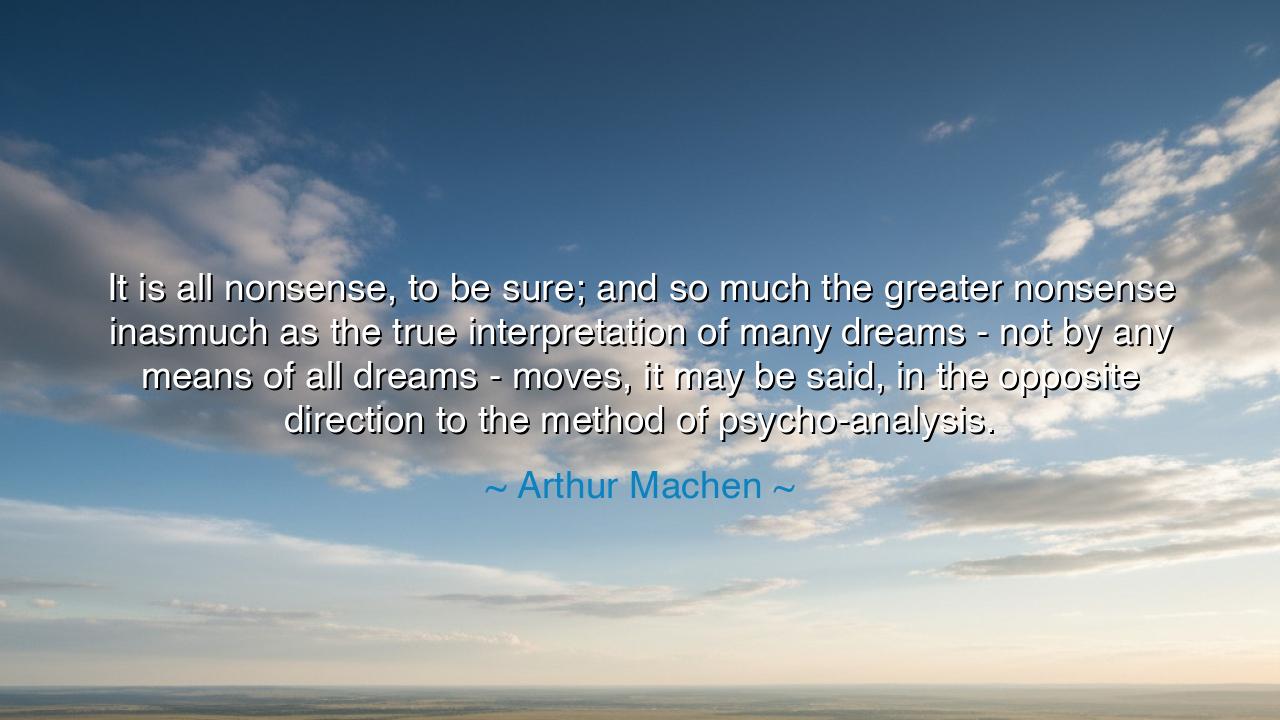
It is all nonsense, to be sure; and so much the greater nonsense
It is all nonsense, to be sure; and so much the greater nonsense inasmuch as the true interpretation of many dreams - not by any means of all dreams - moves, it may be said, in the opposite direction to the method of psycho-analysis.






The words of Arthur Machen, mystic and master of the uncanny, carry the depth of one who has walked between the worlds of dream and waking: “It is all nonsense, to be sure; and so much the greater nonsense inasmuch as the true interpretation of many dreams — not by any means of all dreams — moves, it may be said, in the opposite direction to the method of psycho-analysis.” In this statement, Machen strikes like a bell against the hollow certainties of his age. He challenges the psycho-analytical method, which sought to dissect the dream as though it were a mechanism of the body, a riddle to be solved by the tools of intellect alone. His tone — part irony, part revelation — reminds us that not all mysteries yield to reason, and that dreams, those ancient messengers of the soul, are not to be reduced to formulas or diagrams of the mind.
The origin of this quote lies in Machen’s lifelong struggle with materialism — the modern belief that the world, and by extension the human mind, can be explained entirely through matter and logic. Living in the shadow of the great psychologists like Sigmund Freud, Machen saw in their science a narrowing of vision. Psychoanalysis sought meaning in the hidden desires, fears, and impulses of the flesh; it looked downward, into the depths of the personal subconscious. But Machen — a man of mystic insight — believed that the true interpretation of dreams often moved in the opposite direction: upward, toward the divine, the symbolic, the numinous. To him, the dream was not a symptom of repressed longing but a revelation from the soul’s higher realm — a whisper from eternity clothed in symbol and wonder.
Thus, when Machen calls psychoanalytic explanations “nonsense,” he does not reject the existence of the unconscious; rather, he rejects its confinement to the base and the bodily. He insists that dreams cannot be explained by appetite alone — they are not the echo of hunger or lust disguised in imagery. They are messages, glimpses of another reality, reflections of the spiritual fire that burns within all life. In this, he echoes the voices of the ancients, who saw the dream not as pathology but as prophecy. The Greeks spoke of Oneiros, the divine bringer of dreams, and the Hebrews told of Joseph, who rose from slavery to greatness by interpreting visions sent from God. Such wisdom sees the dream not as a mistake of the mind, but as the language of the divine speaking through the frail instrument of man.
In this light, Machen stands as a defender of mystery — that sacred dimension of existence which modern science, in its pride, often denies. He reminds us that not all truths can be analyzed; some must be felt, experienced, and revered. The dream, he says, belongs to that realm. It is a bridge between the seen and the unseen, and its meanings cannot be pinned to the dissecting table of theory. Psychoanalysis may see symbols of repression; Machen sees symbols of revelation. Where Freud might see the serpent as a token of desire, Machen might see it as a sign of transformation, or of the ancient wisdom coiled within the human spirit. The same image, seen through two different lenses — one of the body, one of the soul — yields two different worlds.
Consider, for example, the dream of Joan of Arc, who, as a peasant girl, heard voices in her sleep commanding her to save France. The psychoanalyst would interpret this as fantasy born of repression, or a projection of unmet desires. But Machen would see something holier: a vision bestowed by the spirit of destiny itself, calling her to fulfill a divine mission. And history, in its unfolding, seems to vindicate the latter. Her dreams moved not from the unconscious depths, but from the transcendent heights — and through them, an illiterate girl altered the fate of nations. So too, Machen would argue, do many of our own dreams carry messages from beyond the intellect’s grasp, if only we dare to listen.
Machen’s wisdom, then, is a warning against spiritual blindness — against the arrogance of reducing mystery to mechanism. The dream is not a mirror of weakness, but a window into the eternal. Its nonsense, as he calls it, is the nonsense of poetry, of parable, of divine truth hidden beneath paradox. He teaches us that to interpret a dream rightly, one must not analyze as a surgeon, but ponder as a priest; not dissect, but contemplate. The true interpreter of dreams does not force meaning from them — he receives it, patiently, reverently, as one receives light filtering through stained glass.
And so, my children, the lesson is this: do not scorn your dreams, nor surrender them to the analysts of the age. Seek their meaning not only in the chambers of the mind, but in the sanctuaries of the spirit. When you wake from a dream, resist the impulse to explain it away — instead, sit in stillness and ask what truth it hides. Some dreams may be born of the body, yes, but others come from the eternal source that moves all souls. Learn to tell one from the other. For Machen’s words remind us of a sacred truth: that the dreamer is more than flesh, and that even nonsense, in the language of heaven, may contain the music of revelation.






AAdministratorAdministrator
Welcome, honored guests. Please leave a comment, we will respond soon